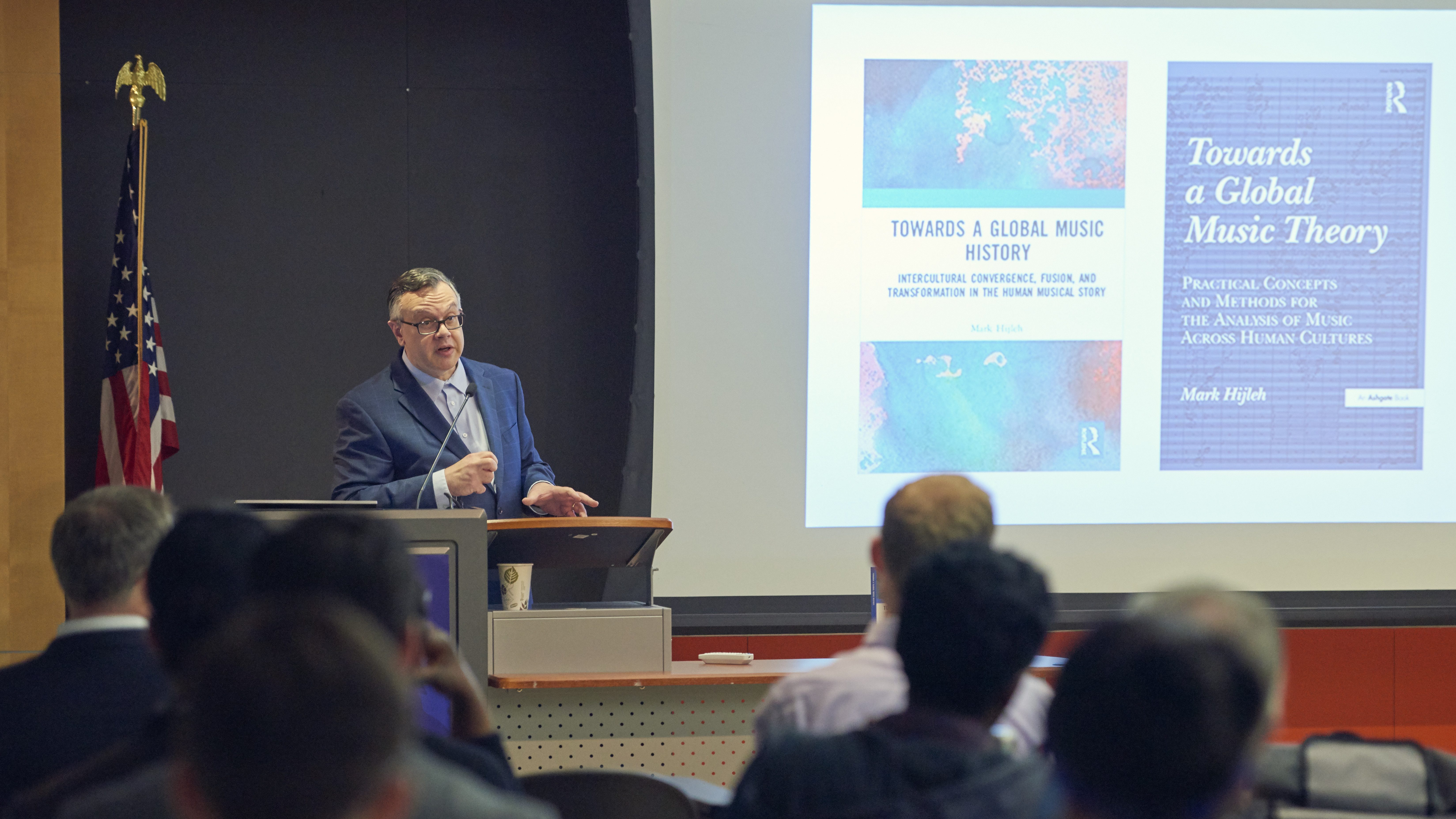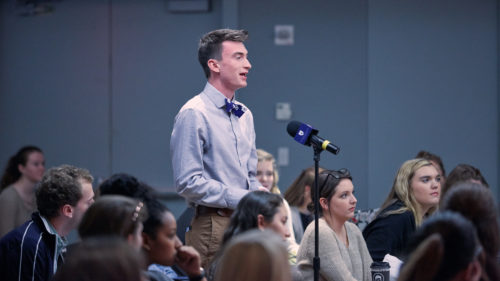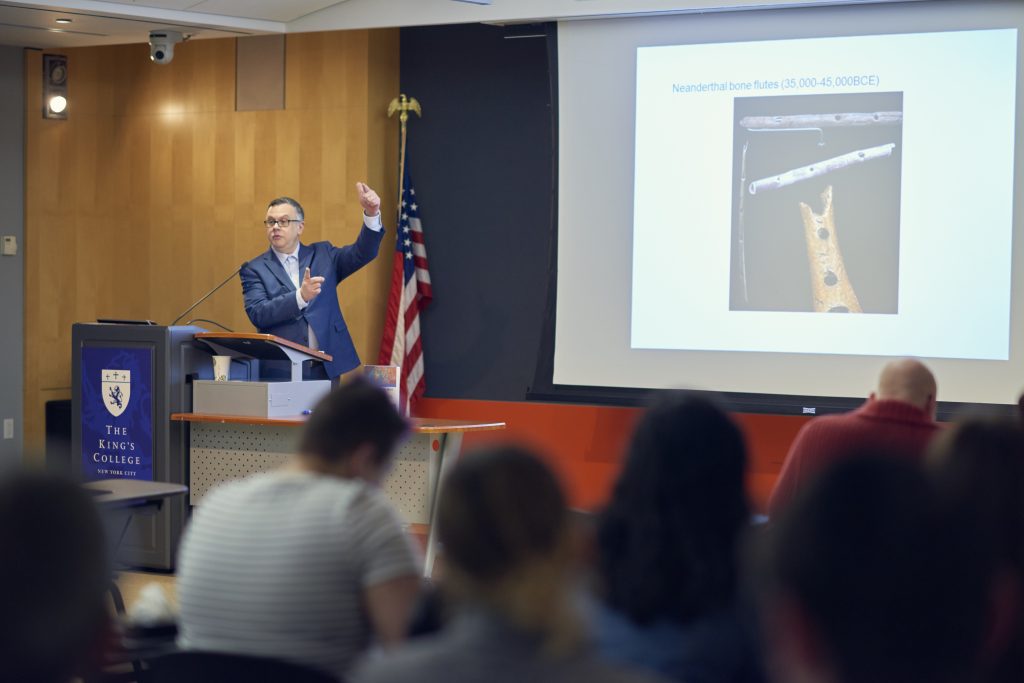Dr. Mark Hijleh Launches Book ‘Towards a Global Music History’
Professor in Music Dr. Mark Hijleh launches his second book detailing how musical traditions around the globe have intersected throughout the centuries to form the modern transcultural music scene.

On May 2, 2019, The King’s College hosted the New York City launch of a new book by Dr. Mark Hijleh, Towards a Global Music History: Intercultural Convergence, Fusion, and Transformation in the Human Music Story. In addition to serving as provost, Hijleh is a professor in music at King’s. The focus of his musical career has evolved over more than 30 years, from pianist to composer and conductor to, most recently, a scholar exploring music as a universal human activity at the intersections of ethnomusicology, theory and analysis, and history.
Towards a Global Music History is the second book in a series that began seven years ago with Towards a Global Music Theory: Practical Concepts and Methods for the Analysis of Music across Human Cultures. Hijleh’s aim is to reimagine what music education can and should be in a 21st-century global world, and studies such as these are needed to spur further thinking along those lines.
In his presentation at the launch, Hijleh asserted that “21st-century musicians can and should become experts in understanding human musics and their history as synthesis” rather than only as individual styles dictated by cultural differences. He noted,
All histories reflect choices, and the one outlined here posits that the human musical story is best understood, in 21st-century retrospect, from a global developmental perspective in the context of intercultural convergence, with travel and trade as the primary defining conditions and catalysts. The speed and effect of these intercultural convergences has increased as developing technologies have enabled them over time, eventually approaching the level of instantaneous musical exchange, fusion, and global transculturality that we observe today.
Hijleh demonstrated this by providing an overview of the book and its thesis with maps, pictures, and audio examples. He explained,
There have been three particularly pivotal inter- or transcultural convergences that can be seen as defining the shape of human musical history. Each led to the next in some ways, and each was part of an acceleration into this age of global instantaneous exchange in which we of the 21st-century find ourselves. Two of these convergences coalesced in the Afro-Eurasian Old World and the third in the New World of the Americas. The first unfolded from about 200 B.C.E. to 900 C.E. along a collection of developing trade pathways across the heart of Central Asia, one of which dipped further south into Indian and Persian territory, that came to be called the Silk Road. This Road was anchored by two great empires on either end—Rome in the West and Han China in the East—but encompassed a wide variety of cultures in between that had considerable impact. The second convergence arose in North Africa, the Iberian Peninsula, and further north into other parts of Europe from about 700 to 1500 C.E., emerging and spreading from what the Arabs called al-Andalus. And the third sprang dramatically from about 1500 C.E. in the Americas with the full flowering of Atlantic culture, proceeded to accelerate into and through the 20th century, and finally exploded into what can be called the current transcultural age.
Following the presentation, Hijleh fielded questions from the audience, which included one he says he gets a lot: “How can we know what ancient music sounded like, when there are no audio recordings?” Hijleh noted that we have various kinds of musical notation to work with, and, though many world cultures did not develop these, some are surprisingly old, such as theoretical treatises and notations from the Sumerians from nearly 5,000 years ago. Other cultures have robust oral traditions, in which ancient practices survive, while many others recorded detailed visual and literary depictions of musical sound and performance that provide clues as to how to construct instruments and how to perform the music. Some instruments actually survived and have been discovered in archaeological digs over the centuries.
Other questions revolved around criticisms Hijleh says he has heard before, including whether his approach is too reductionist to adequately represent human musical diversity. Hijleh counters with the fact that his thesis does not seek to erase differences between musical cultures, but rather to show how readily identifiable human musical universals—stemming from human physiology and psychology, as well as from acoustic principles clearly evident in many cultures across times and locations—have been and are continuing to be worked out into different musical styles.
Both Towards a Global Music History and Hijleh’s earlier Towards a Global Music Theory are published by Routledge and are available online from a number of vendors.





